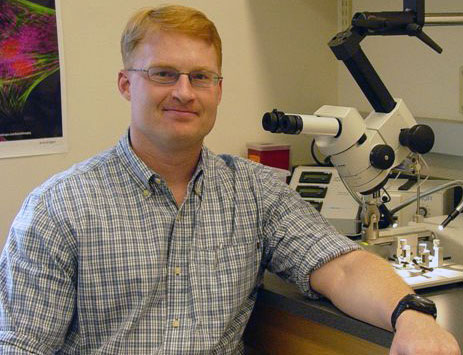Thomas A. Knight, Ph.D.
Associate Professor
Biology Department
Whitman CollegeEMAIL or Phone: 509.524.2010

|
 |
Research trajectory and projects: I am a neuroscientist working to describe the neural mechanisms underlying behavior (primarily movement and motor learning) in order to further our understanding of brain function and to improve treatment for those with movement deficits (e.g., Parkinson's Disease). I primarily examine the control of eye and head movements of mammals to advance our understanding of mechanisms of movement coordination, sensorimotor integration, neural circuitry, neural plasticity, and neuropathology. To study these features of the brain, my students and I map neural circuits (with neuroanatomical histochemistry), record and manipulate the electrical activity of neurons (electrophysiology) in mice, and, since 2011, have begun examining oculomotor (eye) and cephalomotor (head movement) behavior in humans (videooculography) with noninvasive, portable eye-tracking equipment (the EyeSeeCam). Because humans rely on vision so extensively, there are several exciting links between basics of eye-head coordination and cognitive neuroscience (e.g., attention, decision making, and perception), developmental and social psychology, etc. Students in my lab join me in working to answer questions like: 1. Is the anatomy of the brain connections in the laboratory mouse similar to that in cats, monkeys and humans? Do the neurons and circuits behave similarly in the mouse? If the answer to these questions is yes, we can next work to determine which genes in mice are critical for function. 2. How are large-amplitude (e.g., 90 deg), combined eye-head gaze shifts controlled for accuracy? Are there differences in brain mechanisms of control for different forms of gaze shifts (e.g., memory guided v. visually guided)? What regions of the brain are necessary for these abilities? 3. Current models of eye-head coordination cannot explain differences in eye and head movement proportions between subjects completing identical tasks. Is there no single mechanism by which the human brain coordinates accurate, combined eye-head gaze shifts? What social contexts and behavioral needs might be influence the fundamental strategy? 4. Can precise measurements of combined eye-head gaze shifts allow early detection of brain impairment or disease like concussion/mTBI, Post-traumatic Stress Disorder (PTSD), or Parkinson's Disease (PD)? Can these observations be used to determine the precise regions of the brain impairment? Click to read more. These questions all directly involve the same central, cohesive thread -- brain control of eye and head coordination -- and my research in this field across several years allows me to integrate information from across several species, behaviors, methodologies, and levels of analysis. I am very happy that my students and I are now in a position to translate "at the bench science" into human-centered applications (e.g., in the diagnosis of concussion, or mild Traumatic Brain Injury (mTBI)). While my research focusing directly on humans is relatively new, my research program and its results are immediately valuable for Whitman students and the neuroscience community. My peer-reviewed work published (2), funded (1), submitted (2), or presented professionally (3) since my arrival at Whitman in 2006 demonstrates a sustainable, long-term trajectory that will reveal important new information and contribute to Whitman's educational objectives (publications, grants and presentations, respectively; student authors indicated with "*"):
If you are a student interested in any of these questions or publications, please contact me (knightt AT whitman DOT edu) and we can meet to discuss these topics, research in my laboratory, and coursework that might outfit you for exploring these types of topics. |